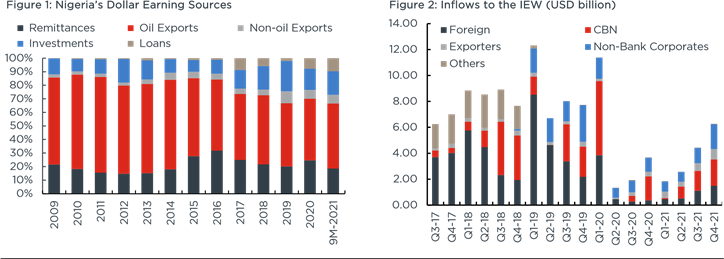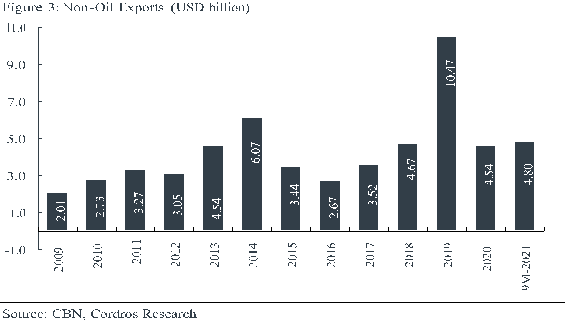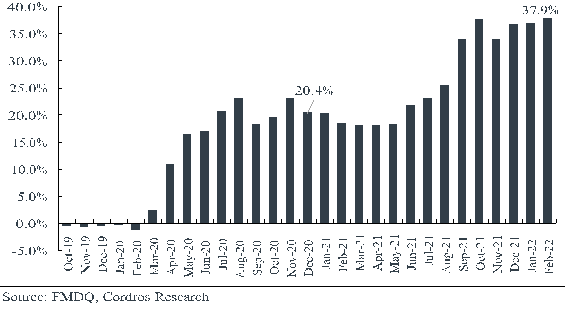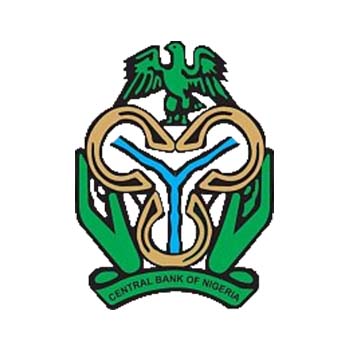Analyst: Abdulazeez Kuranga
On 25th February, the Central Bank of Nigeria (CBN) released the operating guidelines for the non-oil export proceeds repatriation rebate scheme as introduced in the RT200 FX programme. Precisely, the guideline stipulates that exporters will be paid (1) N65.00 for every USD1.00 repatriated and sold at the Investors and Exports Window (IEW) to Authorised Dealing Banks (ADBs) for other third party use, and (2) NGN35.00 for every USD1.00 repatriated and sold at the IEW for own use on eligible transactions only.
Meanwhile, the RT200 FX programme or “Race to $200 billion in FX Repatriation” aims to attain a goal of USD200.00 billion in FX repatriation from non-oil exports over the next three to five years. In addition, the scheme would rest on five key anchors – (1) non-oil commodities expansion facility, (2) dedicated non-oil export terminal, (3) non-oil FX rebate scheme, (4) value-adding exports facility, and (5) biannual non-oil exports summit.
In this report, we accessed the CBN’s motive for the scheme, analysed the effectiveness on the FX market, and identified the potential constraints that could hamper the scheme’s progress.
The CBN’s Move to Improve FX Repatriation through Non-Oil Exports As a start, export earnings constitute the most significant portion of the aggregate US dollar earnings for the country. Based on the data obtained from the CBN, export earnings contributed 62.8% of Nigeria’s total dollar earnings between 2009 and 2020. Simultaneously, remittances and investments contributed 21.2% and 13.4%, respectively.
Although Nigeria’s domestic production base is diversified away from crude oil, export earnings remain tilted towards oil exports. Precisely, crude oil and gas exports accounted for 87.8% of total exports between Q1-18 and Q3-21, while non-oil exports contributed 12.2%.
Thus, the country’s export earnings have always been susceptible to fluctuations in the price of crude oil, which is not within the control of policymakers. For context, low crude oil prices in 2016FY and 2020FY were critical determinants in the economic contractions witnessed during those periods.
Consequently, we believe the dynamic risks of crude oil price fluctuations on the economy is a significant factor that spurred the CBN’s move to introduce measures that have the potential of bringing sustainable foreign exchange (FX) to the country.

Moreover, foreign investors have historically dominated FX inflow to the IEW, with support from the CBN. Specifically, between May 2017 (when operations started at the IEW) and January 2021, foreign investors’ inflows amounted to USD50.52 billion (or 42.8% of total inflows to the IEW), while the CBN contributed 25.3%. Other contributions to the IEW inflows during the review period included non-bank corporates (14.9%), exporters (5.3%) and others (11.7%). However, foreign inflow, which is the most significant component of IEW inflows, is dominated by portfolio inflow (84.8% of inflows from foreign investors). These portfolio investments are volatile as investors tend to seek to repatriate funds during periods of economic stress.
The Non-Oil Export Proceeds Repatriation Rebate Scheme
According to the operating guidelines from the CBN, the rebate scheme is designed to incentivise non-oil exporters to encourage the sale of FX proceeds and encourage repatriation into the FX market. Thus, the key objectives of the rebate scheme include (1) enhancing FX inflow, (2) diversifying FX inflow sources, (3) increasing the contribution of non-oil exports to total exports, (4) ensuring FX inflow stability and sustainability, and (5) supporting export-oriented companies in expanding export operations and capabilities. Although the rebate scheme is just one of the five key anchors of the RT200 FX programme, the CBN aims to raise USD200.00 billion in FX earnings from non-oil export proceeds over the next three to five years.
For us, we see the rebate scheme as a tacit devaluation of the Naira to serve as an incentive for non-oil exporters to repatriate their proceeds into the FX market. That said, we believe the most significant factor responsible for the low repatriation of non-oil export proceeds into the FX market is low aggregate nonoil export earnings. Others include the (1) wide margin between the official and parallel market exchange rate and (2) lack of flexibility in the country’s exchange rate framework. On the second point, we suspect that the majority of the exporters prefer to keep their proceeds in offshore accounts for raw material import payments.

Is a Rebate Scheme Effective Enough to Boost Non-Oil Exports?
Given the preceding, how effective can the rebate scheme be in improving FX supply and subsequently supporting the Naira exchange rate to the US Dollar?
In assessing the potential effect of the rebate scheme, we first looked at inflows to the IEW from exports during periods of proper exchange rate alignment. Our findings suggest export inflows to the IEW in this period were low. For instance, between 2018FY and 2019FY, monthly FX inflow to the IEW from exporters averaged USD93.89 million (0.03% of average monthly inflows of USD2.86 billion into the IEW during the review period). We think this has been due to the uncertainties surrounding the country’s FX framework, which has led exporters’ preferring to keep proceeds in offshore accounts to reduce business risk related with constant currency fluctuations. Hence, we find it hard to see how the rebate scheme could significantly increase repatriation proceeds into the IEW. Instead, it would serve the exporters as compensation for the significant premium (37.9% as of February 2022 vs December 2020: 20.4%) between the IEW and parallel market exchange rate.
On the premium between the IEW and parallel market exchange rates, we note that exporters have an incentive to either (1) leave their export proceeds in offshore bank accounts or (2) bypass the system and sell some of their proceeds at the parallel market. In essence, we think the rebate scheme would still not be enough to compensate for the significant FX premium fully. Putting things in a better perspective, given the IEW exchange rate (NGN416.50/USD as of 14th March), a NGN65.00 rebate for every USD1.00 repatriated takes it to an effective conversion rate of NGN481.50/USD. This effective conversion rate is still 16.8% below the parallel market exchange rate (NGN579.00/USD as of 11th March).
Figure 4: Trend in the Parallel Market Premium

On a balance of factors, we think the new policy will have a limited impact in the short-to-medium term. Hence, we do not believe it would significantly improve FX liquidity and, by extension, may not lead to exchange rate convergence. Consequently, we expect the parallel market exchange rate to remain pressured in 2022FY, more so that election uncertainties would dominate H222 amidst the lingering FX liquidity challenges. Therefore, we maintain our view that the currency will trade between NGN440.00/USD and NGN460.00/USD at the IEW by the end of 2022FY. Over the short-to-medium term, we believe a significant increase in FX supply at the parallel market and improved flexibility at the IEW are instrumental in narrowing the gap between the IEW and parallel market exchange rate.
That said, we laud the CBN for coming up with the RT200 FX programme to boost the contribution of non-oil export earnings to the country’s total foreign exchange earnings. Notably, we like one of the programme’s anchors, which involves creating a dedicated non-oil export terminal. A dedicated terminal for non-oil export could serve as a key to partly reducing the bottlenecks involved in the number of months containers wait before they are shipped for exports. However, we believe a non-oil export terminal will not be enough to drive the significant non-oil exports needed to achieve the programme’s aim over the medium term. Besides, we think the presence of structural bottlenecks and administrative challenges at the ports will continue to undermine the competitiveness of Nigeria’s non-oil exports in the global market. Accordingly, we believe adequate support from the fiscal authorities would be significant in boosting non-oil exports and solving the exchange rate issues.
Kuranga, an analyst at Cordros Capital can be reached via abdulazeez.kuranga@cordros.com








